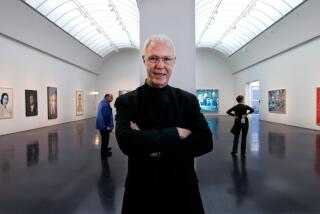Richard Lippold, 87; Created Abstract Sculpture
Richard Lippold, creator of gigantic abstract metal sculptures that sparkle and soar in prominent places--including Lincoln Center and the Four Seasons restaurant in New York City and the Orange County Performing Arts Center in Costa Mesa, where his red, gold and silver “Fire Bird” flies through a glass facade, has died. He was 87.
Augusto Morselli, his companion of 28 years, said Friday that Lippold died Aug. 22 of kidney failure at a hospital in Roslyn, N.Y.
Morselli said that Lippold continued to draw new designs, including one for a 200-foot-tall memorial to victims of the World Trade Center disaster, until his final two-week hospitalization.
“He saw his works as an affirmation of life,” said Curtis L. Carter, who as director of the Haggerty Museum of Art at Marquette University in Lippold’s native Milwaukee, curated a 1990 retrospective of the sculptor’s work. “He thought that light and space were the vocabulary of the 20th century artist. His work has a sense of openness, and implies a kind of upward, celebratory movement.”
Lippold wrote of finding inspiration in the technological discoveries of his time: “Born into a place and an age in which space and time are our principal companions, I feel it inevitable to love them more than the solid materials with which my ancestors were involved.” But Carter, who became a close friend of the sculptor, said he also spoke of German baroque church art and the land and sky of the Midwest as important influences.
Among Lippold’s prominent works are “Orpheus and Apollo” (1961), a 190-foot-long piece suspended over the lobby at Lincoln Center’s Avery Fisher Hall, and the delicate, cloud-like 22-square-foot bronze sculpture over the bar at the Four Seasons. “Ad Astra” (1976), a 115-foot-tall twin spire, stands outside the National Air and Space Museum in Washington, D.C.; “Flight” (1963) graces the lobby of what is now the MetLife Building in New York City.
“The Sun,” commissioned by New York’s Metropolitan Museum of Art in 1953, used nearly two miles of wire filled with 22-carat gold, held together by 14,000 hand-welded joints. It took three years to create and caused a sensation, although not all authorities were impressed. “Not sculpture, but a kind of charade of sculpture which, while hinting at vast conceptions, makes its points very much as window decoration catches the eye,” wrote critic Hilton Kramer in Arts magazine.
“If you opened Time or Newsweek or art magazines in the 1960s, you’d find his name and a lot of publicity,” said Carter. “His work in recent times hasn’t been as much in fashion as in the ‘60s and ‘70s. But I would rank him as one of the major modern American sculptors.”
“Fire Bird,” from 1986, is an example of Lippold’s combination of gigantic scale and shining aspiration. It was commissioned by the Orange County Performing Arts Center’s leading benefactors, the Segerstrom family, and named by the late Renee Segerstrom, who loved Stravinsky’s ballet, “The Firebird.” Fabricated from three tons of aluminum and stainless steel, supported by 490 cables, it is 60 feet tall, 120 feet wide and 100 feet deep.
“That sculpture has been such an incredible signature of this place,” said Jerry Mandel, president of the Orange County Performing Arts Center. Mandel said that every few years, including a visit two years ago, Lippold would come by “just to check it out” and make sure it was being well-maintained. Other Lippold works in California include “Flying Emeralds,” in the lobby of San Diego’s Emerald Plaza office and hotel complex, and his 150-foot-tall altar canopy for St. Mary’s Cathedral in San Francisco. Carter rates that 1970 assemblage of thousands of polished aluminum prisms as perhaps Lippold’s most beautiful.
Lippold, the son of a mechanical engineer, studied industrial design at the Art Institute of Chicago and had his own practice for two years after graduating in 1937. He also studied piano and organ and composed music in his spare time. He taught design at the University of Michigan and married Louise Greuel, a dancer, in 1940. His first sculpture, in 1942, was a collage of himself and his wife, made of newspapers and baling wire retrieved from the Ann Arbor city dump. They moved to New York City in 1944, she to study under Martha Graham and Merce Cunningham, he to sculpt. He fell in with avant-gardists such as Jasper Johns and John Cage--small wire sculptures by Lippold adorned Cage’s loft.
Gallery shows through the late 1940s led to a 1950 commission from architect Walter Gropius to make an outdoor sculpture at Harvard University. Budding satirist Tom Lehrer lampooned the result, “World Tree,” in the Harvard Crimson: “Of all the thoughts of Mr. Gropius/This cosmic hat rack is the dopius.” But Lippold’s career was taking off, helped by his reputation as an artist who collaborated well with architects.
Eventually, Carter said, Lippold owned homes in Vermont and Italy, as well as his main residence in Lattingtown, N.Y., where he kept a collection of Rolls-Royces and built his own pipe organ.
“He always said he wasn’t interested in being well-known; what he wanted was to have his work experienced,” Carter said.
“He’s the most unknown great artist around. You ask around, ‘Who’s Lippold?’ and nobody knows, but that’s what he wanted,” said Morselli. Morselli said it was Lippold’s wish to be cremated and have his remains launched into space: “He said, ‘I came from space, I want to go back to space.’ In due time, we will honor his wish.”
Lippold’s survivors also include his wife, two daughters and a son, as well as seven grandchildren.
More to Read
The biggest entertainment stories
Get our big stories about Hollywood, film, television, music, arts, culture and more right in your inbox as soon as they publish.
You may occasionally receive promotional content from the Los Angeles Times.











